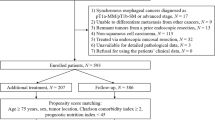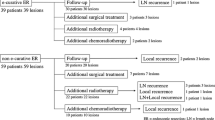Abstract
Background
Esophageal squamous cell carcinoma (ESCC) confined to the muscularis mucosae (MM) or up to 200 µm of the submucosa (SM1) confers the risk for lymph node metastasis, and is defined as relative indication for endoscopic submucosal dissection (ESD) by the Japan Esophageal Society guidelines. Although additional surgical treatment after ESD is recommended, long-term outcomes of ESD compared with those of surgery have not been clarified. This study aimed to evaluate the long-term outcomes of ESD and surgery for cN0M0 relative indication lesions of ESCC.
Methods
Between 2006 and 2016, patients with relative indication lesions of ESCC who underwent ESD or surgery at nine participating hospitals were examined retrospectively. Using propensity score matching, we evaluated survival curves for and hazard ratios associated with endoscopic submucosal dissection and surgery.
Results
In total, 155 lesions in the ESD group and 106 lesions in the surgery group met the pathological criteria of relative indication for endoscopic resection. After matching, 50 matched pairs of patients who underwent ESD or surgery were selected. The 5-year overall survival rates were 84.5% [95% confidence interval (CI) 68–93] in the ESD group and 79% [95% CI 60–90] in the surgery group. The hazard ratio of mortality for ESD compared with that for surgery estimated by Cox regression analysis was 0.79 (95% CI 0.3–2.06, p = 0.63).
Conclusions
Compared with surgery, ESD does not compromise long-term outcomes. ESD alone or ESD with chemotherapy and/or radiotherapy may be an option for the treatment of MM and SM1 ESCC.




Similar content being viewed by others
References
Ferlay J EM, Lam F, Colombet M, Mery L, Piñeros M, Znaor A, Soerjomataram I, Bray F, editors. Cancer today (powered by GLOBOCAN 2018) IARC CancerBase. 2018; No. 15.
Torre LA, Bray F, Siegel RL, et al. Global cancer statistics, 2012. CA Cancer J Clin. 2015;65:87–108.
Berger A, Rahmi G, Perrod G, et al. Long-term follow-up after endoscopic resection for superficial esophageal squamous cell carcinoma: a multicenter Western study. Endoscopy. 2019;51:298–306.
Yamashina T, Ishihara R, Nagai K, et al. Long-term outcome and metastatic risk after endoscopic resection of superficial esophageal squamous cell carcinoma. Am J Gastroenterol. 2013;108:544–51.
Araki K, Ohno S, Egashira A, et al. Pathologic features of superficial esophageal squamous cell carcinoma with lymph node and distal metastasis. Cancer. 2002;94:570–5.
Makuuchi H, Shimada H, Mizutani K, et al. Clinical pathological analysis of surgically resected superficial esophageal carcinoma to determine criteria for deciding on treatment strategy. Diagn Ther Endosc. 1997;3:211–20.
Kitagawa Y, Uno T, Oyama T, et al. Esophageal cancer practice guidelines 2017 edited by the Japan Esophageal Society: part 1. Esophagus. 2019;16:1–24.
Sobin LHGM, Wittekind C. TNM classification of malignant tumours. 7th ed. New York: Wiley; 2009.
Kitagawa Y, Uno T, Oyama T, et al. Esophageal cancer practice guidelines 2017 edited by the Japan esophageal society: part 2. Esophagus. 2019;16:25–43.
Kuwano H, Nishimura Y, Ohtsu A, et al. Guidelines for diagnosis and treatment of carcinoma of the esophagus April 2007 edition: part I edited by the Japan Esophageal Society. Esophagus. 2008;5:61–73.
Kuwano H, Nishimura Y, Oyama T, et al. Guidelines for diagnosis and treatment of carcinoma of the esophagus April 2012 edited by the Japan Esophageal Society. Esophagus. 2015;12:1–30.
Japan Esophageal Society. Japanese classification of esophageal cancer, 11th edition: part I. Esophagus. 2017;14:1–36.
Society JE. Japanese classification of esophageal cancer, tenth edition: part I. Esophagus. 2009;6:1–25.
Kanda Y. Investigation of the freely available easy-to-use software 'EZR' for medical statistics. Bone Marrow Transplant. 2013;48:452–8.
Igaki H, Kato H, Tachimori Y, et al. Clinicopathologic characteristics and survival of patients with clinical stage I squamous cell carcinomas of the thoracic esophagus treated with three-field lymph node dissection. Eur J Cardiothorac Surg. 2001;20:1089–94.
Wani S, Drahos J, Cook MB, et al. Comparison of endoscopic therapies and surgical resection in patients with early esophageal cancer: a population-based study. Gastrointest Endosc. 2014;79(224–232):e221.
Shimizu Y, Tsukagoshi H, Fujita M, et al. Long-term outcome after endoscopic mucosal resection in patients with esophageal squamous cell carcinoma invading the muscularis mucosae or deeper. Gastrointest Endosc. 2002;56:387–90.
Minashi K, Nihei K, Mizusawa J, et al. Efficacy of endoscopic resection and selective chemoradiotherapy for stage I esophageal squamous cell carcinoma. Gastroenterology. 2019;157(382–390):e383.
Funding
None declared.
Author information
Authors and Affiliations
Consortia
Contributions
KY, MN, RT, KM, TI, MY, TT, and ST collected the data; KY designed and analyzed the data; KY and MI drafted the manuscript; HK, SK, YK, YS, and HO revised the manuscript for important intellectual content. All authors have read and approved the final version to be published.
Corresponding author
Ethics declarations
Ethical statement
As the patients were registered and analyzed retrospectively in this observational study, the need for written informed consent was waived. All procedures followed were in accordance with the ethical standards of the responsible committee on human experimentation (institutional and national) and with the Helsinki Declaration of 1964 and later versions.
Conflict of interest
The authors declare that there are no conflicts of interest associated with this article.
Additional information
Publisher's Note
Springer Nature remains neutral with regard to jurisdictional claims in published maps and institutional affiliations.
Electronic supplementary material
Below is the link to the electronic supplementary material.
Rights and permissions
About this article
Cite this article
Yamauchi, K., Iwamuro, M., Nakagawa, M. et al. Long-term outcomes of endoscopic versus surgical resection for MM-SM1 esophageal squamous cell carcinoma using propensity score analysis. Esophagus 18, 72–80 (2021). https://doi.org/10.1007/s10388-020-00775-0
Received:
Accepted:
Published:
Issue Date:
DOI: https://doi.org/10.1007/s10388-020-00775-0




